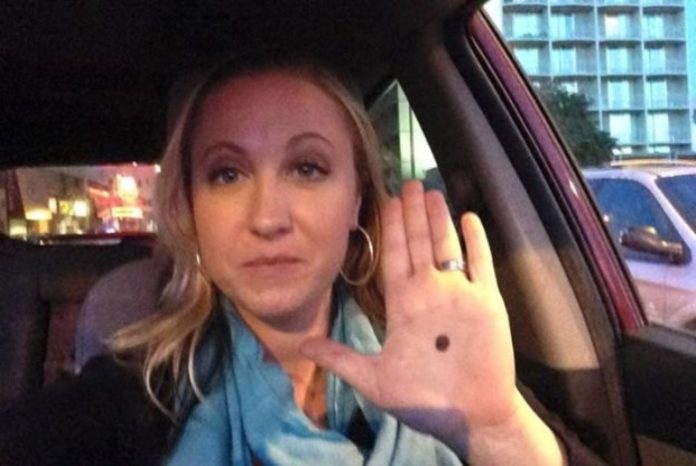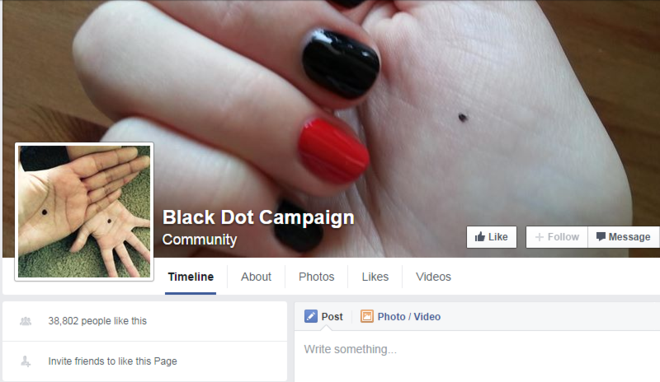
A new social media campaign was started in September 2015 to give victims of domestic violence a new way to ask for help. The Black Dot Campaign was an initiative that encouraged women to draw a small black dot on the palm of their hand as a silent plea to alert friends and family that they were domestic abuse victims, and in trouble. Started on Facebook to identify and help the most vulnerable victims of domestic violence, the novel idea for empowering abused women soon went viral.
The black dot on the hand lets professionals know you’re a really vulnerable domestic violence survivor, and that you…
Posted by Jenn Hunton on Sunday, September 13, 2015
The campaign was launched by Danielle Tredgett, a domestic violence survivor who faced physical, emotional and sexual abuse for a long time. The campaign’s Facebook page, which has since been taken down, stated on September 8:
The Black Dot Campaign is to enable victims who cannot ask for help verbally to ask for help with a simple black dot and people recognise this and help. This is a campaign to help the most vulnerable victims of Domestic Violence. They simply draw a black dot on their hands and agencies, family, friends, community centres, doctors, hospitals can recognise this person needs help but cannot ask for it.
However, after many users expressed concern that an abuser could see the dot instead of someone in a position to offer help, the organizers tried to clear the air with a lengthy Facebook post:
The original ethos for this campaign was to enable a victim to put a dot on their hand around someone they trusted to enable a conversation to start, so they could open that door and hopefully start a process of seeking professional help. This is an idea, thinking outside of the box, trying to open up the world’s eyes and ears to what is going on in terms of abuse. The idea came from a former domestic violence victim.
Professional bodies have not been advised or trained in the Black Dot, what it symbolises and what it means. When people contact us we open the gates of communication and put them in touch with people who can really help.
Putting such a campaign on Facebook was about raising awareness on a social media platform. This isn’t the solution that will help everyone, if anything it should help people realise what abuse is, how it affects people and how to access help.
And most importantly SAFETY MUST ALWAYS COME FIRST. If you see a black dot or are approached by someone for help, if safe to do so take them to safety and get them in contact with the relevant agency. Intervention and support should only be done by professionals.
Dina Polkinghorne, executive director of domestic violence prevention organization Project Sanctuary, later shared her opinion in a statement:
“The Black Dot Campaign is a very well-meaning idea, but a bad idea nonetheless. The campaign is getting a lot of attention, so abusers may also be aware of it. They might question why their partner would have the dot on their hand. A well-meaning family member could also see the dot, and inadvertently compound the violence.”
Project Sanctuary does not endorse the #blackdotcampaign pic.twitter.com/6knvAwli8G
— Project Sanctuary (@p_sanctuary) September 20, 2015
In her response, Tredgett told BBC that critics had missed the point and that the campaign was never about encouraging victims to post selfies online.
“I imagined it as a tool to start face-to-face conversations between friends, or with professionals. I was basing it on my experiences and I was thinking, how could I prompt people to talk about domestic violence? A black dot is easy to make, and easy to erase. As a female, you could go to the toilet, draw one on with mascara, and then later wipe it out. Being in the centre of your palm, you could close your palm and hide it from view. As a way of seeking help, it’s not going to be a solution for everybody. As a victim, you know what triggers your abuser. So if it’s not safe to draw a black dot, don’t do it. Just because you’re a victim doesn’t mean you’re stupid – you know yourself what is safe and what is not safe.”
Despite criticism against the campaign and removal of campaign’s page from Facebook, it shows no signs of slowing. The campaign has now spread and women across the world are drawing black dots on their palms to show they are survivors of abuse and to support the victims.
what a great idea #BlackDotCampaign @LTHTrust @LCHNHSTrust pic.twitter.com/n1b5w3bts3
— Sarah Haygarth (@haygarsa) January 15, 2016
#Blackdotcampaign contre les violences conjugales…… https://t.co/IyQkm4d147 pic.twitter.com/CCoYEjYcKS
— Didier Dubasque (@DDubasque) January 13, 2016
#blackdotcampaign #speakout I’m a lucky woman with a Husband who would never raise a hand, here’s my pic of support pic.twitter.com/o5RrTIBtHJ
— ThisGirlisonFire (@FieryTwoozles) January 11, 2016
Un punto sulla mano per dire basta alla violenza #BlackDotCampaign#conledonnexledonne#StopViolenceAgainstWomenpic.twitter.com/jv03w2f9bw
— Samsung Italia (@SamsungItalia) November 25, 2015
This Article (The Black Dot Campaign Takes The Internet By Storm. Well, Literally!) is free and open source. You have permission to republish this article under a Creative Commons license with attribution to the author and AnonHQ.com.






What about us guys though?
Gonna assume that this goes both ways.
who said you couldnt do this as a guy?
The point is to raise awareness and I think the campaign has gained some exposure. There isn’t one method that’s going to be a cure-all for domestic violence. I support the #blackdotcampaign
Everyone here are victims, OMG! is there any pizza left?
The dumb thing is that now you’re publishing the meaning everywhere and maybe some women/men that uses the black dot will get caught by the asshole being violent with them. People are dumb.
That’s what I thought, now abusers will be looking at their victims hands *sigh*
Why was it taken down (the page)